It’s possible that I shall make an ass of myself. But in that case one can always get out of it with a little dialectic. I have, of course, so worded my proposition as to be right either way (K.Marx, Letter to F.Engels on the Indian Mutiny)
Wednesday, November 03, 2021
Immigration, Refugees and Citizenship Canada (IRCC ) is out of touch with the needs of local communities when it comes to funding programs to help newcomers, states a new report by the Association for Canadian Studies (ACS).
“They sit and make decisions from the ivory tower in Ottawa,” said the report in a summary of views from four focus groups comprising newcomer settlement service workers.
The focus group narrative report — Envisioning the Future of the Immigrant Serving Sector — centered around finding solutions to key challenges faced by new immigrants and service providers, which have been exacerbated by the onset of COVID-19.
The most highly discussed topic centred around restrictive and short-term IRCC funding agreements resulting in less innovation and sustainability in the sector.
Participants cited a lack of sustainability within the sector due to strict funding agreements and to the precarious nature of not knowing whether or not a program will continue to receive funding.
While the IRCC has switched to five-year funding agreements, the agreements still need to be negotiated each year, the forum heard.
“The IRCC has ultimate control over deciding which projects receive funding, and many participants felt as though sometimes the IRCC is out of touch with the needs of local communities.”
For instance, The Regional Municipality of York reported that the last funding cycle cut back significantly on employment services due to many newcomers entering Canada through express entry. Immigrants of this class are often expected to be workforce ready.
But many still struggle to find adequate employment due to barriers such as lack of credential recognition, the re-licensure process, underemployment, as well as lack of childcare and/or transportation.
Other examples brought forward by the focus groups include a youth program funded by the IRCC which was not able to provide any field trips for the youths due to the funding for the program not covering any transportation costs.
The South Okanagan Immigrant and Community Services (SOICS) reported that honoraria to support newcomers contributing their time are not covered by the IRCC funding it gets.
Other costs involving building closer relationships with the Indigenous communities through contact and hospitality, are also not covered by IRCC funding.
“There is a bit of a disconnect between the policy side and the operational side of our system when it comes to funding settlement services,” said a focus group participant.
Inconsistencies in funding models was another key issue.
A participant noted that there is a lack of job security and consistency for settlement workers due to funding agreements and program-based funding not covering pensions, long-term employment, or steady salaries.
Several respondents also critiqued the fact that IRCC funding models focus on outputs rather than impact and outcomes and meeting targets, rather than modernizing, innovating, and measuring long-term successes.
‘Counting the numbers’ is particularly unhelpful for rural settlement agencies who do not have large numbers, in which case the quality of settlement support should be the primary focus, said the report.
Similarly, one participant of a large, rural agency felt as though they were penalized for not having enough clients, especially during the pandemic, when fewer clients were able to travel to in-person sessions or find child care.
While discussing solutions for improving funding models, forum participants gave importance to engaging private organizations like banks, universities and social development initiatives.
One example cited involved Immigrant Services Calgary, which has been successful in securing a loan through a program called UCeed Social Impact Fund that was organized through the University of Calgary and Innovate Calgary.
Another solution raised was to scale up small, innovative, successful projects to larger organizations after they have been proven effective, rather than creating large-scale programs that cannot be down-scaled for smaller rural communities.
Multiple participants also discussed the need for increased staffing, as well as retention of service providers who leave to pursue more financially rewarding employment.
“Staff retention is a huge piece for us and that kind of goes more with the wages of the settlement sector,” one participant said.
The report, segmented into four sections — building capacity, best practices, funding models and improving attraction/accessibility of settlement services — provides a base to expand on the solutions uncovered, according to the Association for Canadian Studies, which conducted the research in collaboration with the WES Mariam Assefa Fund.
“We ultimately intend to pilot projects to address the issues and test solutions and recommendations to improve settlement and economic outcomes,” the study concluded.
Fabian Dawson, Local Journalism Initiative Reporter, New Canadian Media
EDMONTON — The province with Canada's largest oil and gas industry has sent one of the country's smallest delegations to the COP26 international climate conference where emissions from that sector are under scrutiny.

It's a missed opportunity, said one Alberta observer.
"It's incredibly good to be there and learn from these events," said Keith Brownsey, a political scientist at Mount Royal University. "It's smart, but apparently we don't think it's all that smart."
New Democrat Opposition Leader Rachel Notley said the United Conservative government has let Albertans down.
"Alberta workers need a seat at that table and the UCP made the decision to leave it empty," she said Wednesday.
A preliminary list of those attending the COP26 meetings in Glasgow, Scotland, shows that of 200 Canadian delegates, two are from the Alberta government. They are officials from Emissions Reduction Alberta, an agency funding emissions-reducing technologies, and are the province's only representatives.
Almost every province has sent more delegates or higher-level representatives to the meetings, which are setting the world's path to reduce greenhouse gas emissions from fossil fuels.
Newfoundland has nine people at the meetings and Manitoba has six. Ontario has four, as does the Northwest Territories. Quebec has 36 representatives.
Five provinces sent environment ministers. Prince Edward Island sent the director and coordinator of its environment department.
Inuit and Métis groups have more representation than Albertans.
There are also more Mounties at the meetings than representatives of the province with, arguably, the most at stake of any Canadian jurisdiction.
On Wednesday, Premier Jason Kenney defended his decision to send a
"We will continue to vigorously defend Alberta's interests in emissions reduction and economic growth to ensure a strong future, but being part of a crowd of 30,000 is not an effective way of doing so," he said.
Kenney said it's more effective to have one-on-one meetings with financial and political leaders.
"We'll continue to have those direct conversations with key decision-makers."
Brownsey said the government has missed an important chance to gather information, make contacts and tell Alberta's story to the rest of the world.
"What goes on at COP has a dramatic impact on us in Alberta," he said.
"Even the Saudis were there, talking about how they were going to reduce emissions. And we sent two delegates?"
Brownsey said being at the conference allows delegates to better understand the positions of other countries.
"We don't know what's going on. We can read the official documents, but it's in the off-hours you find out what these groups are really thinking."
As well, Brownsey said not showing up leaves the field to a federal Liberal government with which Alberta's United Conservatives are often at odds.
"You complain about them, but do nothing to counter them."
Notley, who represented Alberta as premier during the COP21 meeting in Paris, said showing up would have been a good chance to work with Ottawa's new environment minister. She said such meetings allow Albertans to tell their own story.
"I remember a friend sending me a bunch of things from The Guardian (a U.K. newspaper) talking about all the progressive things the province of Alberta was doing. That story's not being told in our absence."
Notley said Alberta has missed a window to pitch the province as an investment destination for renewable energy.
"With all the investment money there, why isn't somebody telling the story about the promise that is our renewable energy industry?"
So far, the COP26 conference has seen announcements from Canada on emissions caps for oil and gas. Banks, insurers and investors managing $160 trillion have pledged to emphasize green investing.
This report by The Canadian Press was first published Nov. 3, 2021.
Bob Weber, The Canadian Press
Study: Algorithm can predict when an adolescent will become suicidal with 91% accuracy
Study reveals which risk factors most strongly associated with suicidal thoughts and behavior among teens
Peer-Reviewed PublicationBRIGHAM YOUNG UNIVERSITY
Researchers from Brigham Young University, Johns Hopkins and Harvard have created an algorithm that can predict suicidal thoughts and behavior among adolescents with 91% accuracy.
The researchers outline their machine learning approach in an article published today in PLOS ONE, where they also detail risk factors that are leading predictors of suicidal ideation and behavior among adolescents: online harassment and bullying.
“Suicide is the second leading cause of death among adolescents in the U.S.,” said Michael Barnes, study coauthor and Associate Dean of the BYU College of Life Sciences. “It’s critical we have a better understanding of the risk factors — and the protective factors — associated with this heartbreaking issue.”
The study results show researchers can predict with high accuracy which adolescents will exhibit suicidal thoughts (consider or planning) or suicidal behavior (attempting) based on experiences they face.
The team analyzed data from 179,384 junior high and high school students, along with those who participated in the Student Health and Risk Prevention survey from 2011-2017. The dataset includes responses to 300+ survey questions and 8000+ bits of demographic information, resulting in a total of 1.2 billion data points that were processed. Researchers then applied various algorithms to the data and found a machine-learning model that accurately predicted which adolescents went on to have suicidal thoughts and behaviors (STB) based on the data provided.
The data showed females were more likely to experience suicidal thoughts and behavior (17.7%) than males (10.8%), and that those adolescents without a father in the home were 72.6% more likely to have suicidal ideation than those that did.
Most importantly, the algorithm discovered which risk factors were the leading predictors of suicidal thoughts and behavior:
- Being threatened or harassed through digital media
- Being picked on or bullied by a student at school
- Exposure/involvement in serious arguments and yelling at home
“This analysis finds the most important root causes of suicidal thoughts and behavior in adolescents and creates risk profiles that give us a clearer picture of adolescents that are at risk,” said study coauthor Carl Hanson, professor of public health at BYU. “If you want to wrap your head around what you can do about it, these profiles are one good place to start.”
Researchers were not surprised to see some of the risk factors that rose to the top — bullying and harassment — but were a bit taken to see the heavy influence from family factors: three of the top ten predictive factors for STB were tied directly to family situations: 1) being in a family where there are serious arguments, 2) being in a family that argues about the same things over and over and 3) being in a family that yells and insults each other.
The team said the implications of the research are critical for prevention programming and policy making. Specifically, they hope policymakers use the STB risk profile and its associate rankings to prepare services, resources, and assessments aimed at school, community and family settings.
“Clearly the results speak to the need for prevention and schools may be the best place to start by helping to mitigate bullying and online harassment. The results also indicate a need to strengthen families,” Hanson said. “For communities, we need programming that can help support and strengthen the family.”
JOURNAL
PLoS ONE
METHOD OF RESEARCH
Data/statistical analysis
SUBJECT OF RESEARCH
People
ARTICLE TITLE
Predicting suicidal thoughts and behavior among adolescents using the risk and protective factor framework: A large-scale machine learning approach
ARTICLE PUBLICATION DATE
3-Nov-2021
COI STATEMENT
The authors have declared that no competing interests exist.
Machine learning can provide strong predictive accuracy for identifying adolescents that have experienced suicidal thoughts and behavior
Factors including online and at-school bullying, serious arguments at home, gender, alcohol use and attitudes about marijuana proved most highly associated with adolescent suicidal thoughts and behavior
Peer-Reviewed PublicationPLOS
IMAGE: FIG 7. THE TOP 10 MOST IMPORTANT QUESTIONS FOR MALES VS FEMALES. view more
CREDIT: WELLER ET AL., 2021, PLOS ONE, CC-BY 4.0 (HTTPS://CREATIVECOMMONS.ORG/LICENSES/BY/4.0/)
Researchers have developed a new, machine learning-based algorithm that shows high accuracy in identifying adolescents who are experiencing suicidal thoughts and behavior. Orion Weller of Johns Hopkins University in Baltimore, Maryland, and colleagues present these findings in the open-access journal PLOS ONE on November 3rd, 2021.
Decades of research have identified specific risk factors associated with suicidal thoughts and behavior among adolescents, helping to inform suicide prevention efforts. However, few studies have explored these risk factors in combination with each other, especially in large groups of adolescents. Now, the field of machine learning has opened up new opportunities for such research, which could ultimately improve prevention efforts.
To explore that opportunity, Weller and colleagues applied machine-learning analysis to data from a survey of high school students in Utah that is routinely conducted to monitor issues such as drug abuse and mental health. The data included responses to more than 300 questions each for more than 179,000 high school students who took the survey between 2011 to 2017, as well as demographic data from the U.S. census.
The researchers found that they could use the survey data to predict with 91 percent accuracy which individual adolescents’ answers indicated suicidal thoughts or behavior. In doing so, they were able to identify which survey questions had the most predictive power; these included questions about digital media harassment or threats, at-school bullying, serious arguments at home, gender, alcohol use, feelings of safety at school, age, and attitudes about marijuana.
The new algorithm’s accuracy is higher than that of previously developed predictive approaches, suggesting that machine-learning could indeed improve understanding of adolescent suicidal thoughts and behavior—and could thereby help inform and refine preventive programs and policies.
Future research could expand the new findings by using data from other states, as well as data on actual suicide rates.
The authors add: “Our paper examines machine learning approaches applied to a large dataset of adolescent questionnaires, in order to predict suicidal thoughts and behaviors from their answers. We find strong predictive accuracy in identifying those at risk and analyze our model with recent advances in ML interpretability. We found that factors that strongly influence the model include bullying and harassment, as expected, but also aspects of their family life, such as being in a family with yelling and/or serious arguments. We hope that this study can provide insight to inform early prevention efforts.”
JOURNAL
PLoS ONE
METHOD OF RESEARCH
Computational simulation/modeling
SUBJECT OF RESEARCH
People
ARTICLE TITLE
Predicting suicidal thoughts and behavior among adolescents using the risk and protective factor framework: A large-scale machine learning approach
ARTICLE PUBLICATION DATE
3-Nov-2021
COI STATEMENT
The authors have declared that no competing interests exist.
Autonomous robotic rover helps scientists with long-term monitoring of deep-sea carbon cycle and climate change
MONTEREY BAY AQUARIUM RESEARCH INSTITUTE
IMAGE: MBARI'S BENTHIC ROVER II TRAVELS ACROSS THE MUDDY SEAFLOOR, TAKING PHOTOGRAPHS AND MEASURING HOW MUCH OXYGEN BOTTOM-DWELLING ANIMALS AND MICROBES ARE USING OVER TIME. THE INFORMATION GATHERED BY THIS AUTONOMOUS ROVER HAS HELPED SCIENTISTS UNDERSTAND HOW CARBON CYCLES FROM THE SURFACE TO THE SEAFLOOR. view more
CREDIT: © 2016 MBARI
The sheer expanse of the deep sea and the technological challenges of working in an extreme environment make these depths difficult to access and study. Scientists know more about the surface of the moon than the deep seafloor. MBARI is leveraging advancements in robotic technologies to address this disparity.
An autonomous robotic rover, Benthic Rover II, has provided new insight into life on the abyssal seafloor, 4,000 meters (13,100 feet) beneath the surface of the ocean. A study published today in Science Robotics details the development and proven long-term operation of this rover. This innovative mobile laboratory has further revealed the role of the deep sea in cycling carbon. The data collected by this rover are fundamental to understanding the impacts of climate change on the ocean.
“The success of this abyssal rover now permits long-term monitoring of the coupling between the water column and seafloor. Understanding these connected processes is critical to predicting the health and productivity of our planet engulfed in a changing climate,” said MBARI Senior Scientist Ken Smith.
Despite its distance from the sunlit shallows, the deep seafloor is connected to the waters above and is vital for carbon cycling and sequestration. Bits of organic matter—including dead plants and animals, mucus, and excreted waste—slowly sink through the water column to the seafloor. The community of animals and microbes on and in the mud digests some of this carbon while the rest might get locked in deep-sea sediments for up to thousands of years.
The deep sea plays an important role in Earth’s carbon cycle and climate, yet we still know little about processes happening thousands of meters below the surface. Engineering obstacles like extreme pressure and the corrosive nature of seawater make it difficult to send equipment to the abyssal seafloor to study and monitor the ebb and flow of carbon.
In the past, Smith and other scientists relied on stationary instruments to study carbon consumption by deep seafloor communities. They could only deploy these instruments for a few days at a time. By building on 25 years of engineering innovation, MBARI has developed a long-term solution for monitoring the abyssal seafloor.
“Exciting events in the deep sea generally occur both briefly and at unpredictable intervals, that’s why having continuous monitoring with Benthic Rover II is so crucial,” explained Electrical Engineering Group Lead Alana Sherman. “If you’re not watching all the time, you’re likely to miss the main action.”
Benthic Rover II is the result of the hard work of a collaborative team of MBARI engineers and scientists, led by Smith and Sherman.
Engineers at MBARI designed Benthic Rover II to handle the cold, corrosive, and high-pressure conditions of the deep sea. Constructed from corrosion-resistant titanium, plastic, and pressure-resistant syntactic foam, this rover can withstand deployments up to 6,000 meters (about 19,700 feet) deep.
“In addition to the physical challenges of operating in these extreme conditions, we also had to design a computer control system and software reliable enough to run for a year without crashing—nobody is there to press a reset button,” explained MBARI Electrical Engineer Paul McGill. “The electronics also have to consume very little power so that we can carry enough batteries to last for a year. Despite all it does, the rover consumes an average of only two watts—about the same as an iPhone.”
Benthic Rover II is about the size of a small car—2.6 meters (8.5 feet) long, 1.7 meters (5.6 feet) wide, and 1.5 meters (4.9 feet) high—and treads gently over the muddy bottom on a pair of wide, rubber tracks.
Researchers deploy Benthic Rover II from MBARI’s vessel, the R/V Western Flyer. The ships’ crew gingerly lowers the rover into the water and releases it to free-fall to the ocean floor. It takes the rover about two hours to reach the bottom. Once it lands on the seafloor, the rover can begin its mission.
First, sensors check the currents flowing along the seafloor. When they detect favorable currents, the rover moves up or across the current to reach an undisturbed site to begin collecting data.
Cameras on the front of the rover photograph the seafloor and measure fluorescence. This distinctive glow of chlorophyll under blue light reveals how much “fresh” phytoplankton and other plant debris has landed on the seafloor. Sensors log the temperature and oxygen concentration of the waters just above the bottom.
Next, the rover lowers a pair of transparent respirometer chambers that measure the oxygen consumption of the community of life in the mud for 48 hours. As animals and microbes digest organic matter, they use oxygen and release carbon dioxide in a specific ratio. Knowing how much oxygen those animals and microbes use is crucial for understanding carbon remineralization—the breakdown of organic matter into simpler components, including carbon dioxide.
After 48 hours, the rover raises the respirometer chambers and moves 10 meters (32 feet) forward, careful not to cross its previous path, and selects another site to sample. It repeats this sampling pattern over and over for the duration of deployment, typically a full year.
At the end of each deployment, the R/V Western Flyer returns to recover the rover, download its data, swap out its battery, and return it to the deep seafloor for another year. Within each year-long deployment, the MBARI team launches another autonomous robot—the Wave Glider—from shore to return quarterly to check on Benthic Rover II’s progress. “The rover can’t communicate with us directly to tell us its location or condition, so we send a robot to find our robot,” explained McGill. An acoustic transmitter on the Wave Glider pings the rover on the seafloor below. The rover then sends status updates and sample data to the glider overhead. The glider then transmits that information to researchers on shore via satellite.
“Data from the Benthic Rover II have helped us quantify when, how much, and what sources of carbon might be sequestered, or stored, in the abyssal seafloor,” said MBARI Senior Research Specialist Crissy Huffard.
For the past seven years, Benthic Rover II has been continuously operational at Station M, an MBARI research site located 225 kilometers (140 miles) off the coast of central California. Station M lies 4,000 meters (13,100 feet) below the ocean’s surface—as deep as the average depth of the ocean—making it a good model system for studying abyssal ecosystems.
Over the past 32 years, Smith and his team have constructed a unique underwater observatory at Station M. Benthic Rover II and a suite of other instruments operate there 24 hours a day, seven days a week, for a full year without servicing.
“The rover’s reliable performance over seven years, spending 99 percent of its life on the seafloor, is a result of many years of testing, troubleshooting, and developing the best techniques to maintain the vehicle,” said Sherman. “It’s a great example of what’s possible when applying technology to challenging problems in science.”
Data collected at Station M show that the deep sea is far from static. Physical, chemical, and biological conditions can change dramatically over timescales ranging from hours to decades.
The surface waters of the California Current over Station M teem with phytoplankton in the spring and summer. These seasonal pulses in productivity cascade from the water column to the seafloor. Much of this sinking organic matter—known as “marine snow”—originated as carbon dioxide in the atmosphere.
Over the past decade, MBARI researchers have observed a dramatic increase in large pulses of marine snow falling to the seafloor at Station M. These episodic events account for an increasing fraction of the yearly food supply at this site. In seven years of operation at Station M, Benthic Rover II recorded significant weekly, seasonal, annual, and episodic events—all providing data that help MBARI researchers understand the deep-sea carbon cycle.
Between November 2015 and November 2020, Benthic Rover II recorded a substantial increase in the rain of dead phytoplankton and other plant-rich debris (phytodetritus) landing on the abyssal seafloor from the waters overhead. A decrease in the concentration of dissolved oxygen in the waters just above the deep seafloor accompanied this windfall of organic matter.
Traditional short-term monitoring tools would not have detected the fluctuations that drive long-term changes and trends. Benthic Rover II has revealed a more complete picture of how carbon moves from the surface to the seafloor.
“Benthic Rover II has alerted us to important short- and long-term changes in the deep sea that are being missed in global models,” underscored Huffard.
The success of Benthic Rover II and MBARI’s ongoing work at Station M highlight how persistent platforms and long-term observations can further our understanding of the largest living space on Earth. With more companies looking to extract mineral resources from the deep seafloor, these data also give valuable insights into the baseline conditions in areas under consideration for industrial development or deep-sea mining.
The ocean is also a crucial component in Earth’s carbon cycle and climate. The ocean and its biological communities are a sink for carbon dioxide. Burning fossil fuels, raising livestock, and clearing forests release billions of tons of carbon dioxide into our atmosphere every year. The ocean has buffered us from the worst impacts by absorbing more than 25 percent of this excess carbon dioxide. Facing a changing climate, understanding how carbon flows between the ocean’s sunlit surface and its dark depths is more important than ever.
About MBARI
MBARI (Monterey Bay Aquarium Research Institute) is a private non-profit oceanographic research center, founded by David Packard in 1987 focused on developing innovative technologies for exploring and understanding the ocean. The mission of MBARI is to advance marine science and technology to understand a changing ocean.
For additional information or images relating to this release, please email pressroom@mbari.org.
JOURNAL
Science Robotics
ARTICLE TITLE
Abyssal Benthic Rover: autonomous long-term monitoring of deep-ocean processes
ARTICLE PUBLICATION DATE
3-Nov-2021
Mapping annual wildfire probabilities across California
Statistical modeling highlights predictive importance of local climate and human activity
Peer-Reviewed PublicationPLOS
IMAGE: ACTIVE FLAME FRONT OF THE ZACA FIRE, THE SECOND LARGEST FIRE ON RECORD IN CALIFORNIA. U.S. FOREST SERVICE. view more
CREDIT: JOHN NEWMAN, WIKIMEDIA, CC0 (HTTPS://CREATIVECOMMONS.ORG/PUBLICDOMAIN/ZERO/1.0/)
Researchers have uncovered new insights into the dynamics that underlie the probabilities of wildfire across the state of California. Isaac Park of the University of California, Santa Barbara, and colleagues present their method and findings in the open-access journal PLOS ONE on November 3, 2021.
Recent wildfires in California and nearby states have demonstrated the need to better understand the dynamics that determine where and when wildfires occur. However, the factors and conditions that interact to contribute to the probability of wildfire—such as the interplay between local vegetation, precipitation, human land use, and more—are diverse and complex, and they vary between locations and over time.
To improve understanding of those relationships, Park and colleagues used a statistical approach known as generalized additive modeling to explore and map annual wildfire probabilities throughout California from 1970 to 2016. This work built on previous research that employed the same technique for longer time scales. In this case, the researchers tailored the method for annual probabilities by incorporating relevant information on local climate variation, human activity, and the amount of time since the previous fire event for each location and year—all at a geographic scale of 1 kilometer.
This analysis uncovered several new insights into wildfire probabilities in California. For instance, the researchers found, both local climate and human activity—such as the dryness of fuel available to burn and housing density—play key roles in determining wildfire probabilities throughout the state. For example, portions of the Southern California mountains such as the Angeles and Los Padres National Forests were at high risk, having plenty of vegetation and therefore fuel availability as well as being close to and at risk from ignitions starting in high-density housing in the Los Angeles metropolitan area.
In addition, in certain environments, the amount of time since the last fire has an important influence; as do short-term climate variations involving extreme conditions, especially in fire-prone shrublands and forests in southern California.
The researchers also showed that their broad-scale, state-wide approach for predicting wildfire probabilities outperformed statistical models developed for certain localized regions. The researchers suggest that this work—and further refinements to their modeling method—could prove valuable for a variety of research and practical applications in such areas as wildfire emissions and hazard mapping for implementation of fire-resistant building codes.
The authors add: “This study presents a powerful tool for mapping the probability of wildfire across the state of California under a variety of historical climate regimes. By leveraging machine learning methods, it demonstrates the distinct ways in which local climate, human development, and prior fire history each contribute to the yearly risk of wildfire over space and time.”
JOURNAL
PLoS ONE
METHOD OF RESEARCH
Computational simulation/modeling
SUBJECT OF RESEARCH
Not applicable
ARTICLE TITLE
Relationships of climate, human activity, and fire history to spatiotemporal variation in annual fire probability across California
ARTICLE PUBLICATION DATE
3-Nov-2021
COI STATEMENT
The authors have declared that no competing interests exist.
1,000 years of glacial ice reveal ‘prosperity and peril’ in Europe
Evidence preserved in glaciers provides continuous climate and vegetation records during major historical events
Peer-Reviewed PublicationAMERICAN GEOPHYSICAL UNION
IMAGE: RESEARCHERS’ ICE CORE DRILLING CAMP ON COLLE GNIFETTI IN 2015. TWO ICE CORES EXTRACTED FROM THIS AREA PRESERVED A CONTINUOUS ONE-THOUSAND-YEAR RECORD OF EUROPEAN CLIMATE AND VEGETATION. view more
CREDIT: MARGIT SCHWIKOWSKI
This press release and accompanying multimedia are available online at:
https://news.agu.org/press-release/1000-years-of-glacial-ice-reveal-prosperity-and-peril-in-europe/
AGU press contact:
Liza Lester, +1 (202) 777-7494, news@agu.org (UTC-4 hours)
Contact information for the researchers:
Sandra Brugger, Desert Research Institute, sandra.brugger@dri.edu (UTC-7 hours)
WASHINGTON—Europe’s past prosperity and failure, driven by climate changes, has been revealed using thousand-year-old pollen, spores and charcoal particles fossilized in glacial ice. This first analysis of microfossils preserved in European glaciers unveils earlier-than-expected evidence of air pollution and the roots of modern invasive species problems.
A new study analyzed pollen, spores, charcoal and other pollutants frozen in the Colle Gnifetti glacier on the Swiss and Italian border. The research found changes in the composition of these microfossils corresponded closely with known major events in climate, such as the Little Ice Age and well-established volcanic eruptions.
The work was published in Geophysical Research Letters, which publishes high-impact, short-format reports with immediate implications spanning all Earth and space sciences.
The industrialization of European society also appeared clearly in the microfossil record and, in some cases, showed up sooner than expected. Pollen from the introduction of non-native crops was found to go back at least 100 years ago and pollution from the burning of fossil fuels shows up in the 18th century, about 100 years earlier than expected.
Existing historical sources such as church records or diaries record conditions during major events like droughts or famines. However, studying data from the glaciers contributes to the understanding of climate and land use surrounding such events, providing non-stop context for them with evidence from a large land area. Precisely identifying the timing of these events can help scientists better understand current climate change.
“The historical sources that were available before, I don’t think [the sources] got the full picture of the environmental context,” said Sandra Brugger, a paleoecologist at the Desert Research Institute in Nevada and lead researcher on the study. “But also, with the ice core, we couldn’t get the full picture until we started collaborating with historians on this. It needs those two sides of the coin.”
Evidence on high
The new study analyzed microfossils frozen in two 82- and 75-meter-long ice cores pulled from the Colle Gnifetti glacier, which are the first two ice cores from the continent of Europe studied for microfossils. Similar studies have sampled ice cores in South America, Central Asia and Greenland, but those regions lack the breadth of written historical records that can be directly correlated with the continuous microfossil data in ice cores.
Over the centuries, wind, rain and snow carried microfossils from European lowlands, the United Kingdom and North Africa to the exposed glacier. Ice in this glacier site dates back tens of thousands of years, and the altitude of Colle Gnifetti — 4,450 meters above sea level — means the ice was likely never subjected to melting, which would mix the layers of samples and create uncertainty in the chronology of the record.
“They can actually pinpoint and identify the relationships between what’s happening on the continent with climatic records inherent in the ice,” said John Birks, a paleoecologist at the University of Bergen who was not associated with the study. “They can develop, in a stronger way, this link between human civilization and change and climate, particularly in the last thousand years or so where conventional pollen analysis is rather weak.”
Evidence of pollution due to fossil fuel combustion also appeared earlier in the chronological record than expected. The researchers found evidence of the early burning of coal in the United Kingdom around 1780, much earlier than the expected onset of industrialization around 1850, which could have implications for global climate change modeling.
The records also showed evidence of pollen from non-native European plants from 100 years ago, showing a long legacy of the existing ecological problems created by invasive species transported across continents through trade.
###
AGU (www.agu.org) supports 130,000 enthusiasts to experts worldwide in Earth and space sciences. Through broad and inclusive partnerships, we advance discovery and solution science that accelerate knowledge and create solutions that are ethical, unbiased and respectful of communities and their values. Our programs include serving as a scholarly publisher, convening virtual and in-person events and providing career support. We live our values in everything we do, such as our net zero energy renovated building in Washington, D.C. and our Ethics and Equity Center, which fosters a diverse and inclusive geoscience community to ensure responsible conduct.
Notes for Journalists:
This research study is published with open access and is freely available. Download a PDF copy of the paper here. Neither the paper nor this press release is under embargo.
Paper title:
“Alpine Glacier Reveals Ecosystem Impacts of Europe's Prosperity and Peril Over the Last Millennium”
Authors:
- Sandra Brugger (corresponding author), Division of Hydrologic Sciences, Desert Research Institute, Reno, NV, USA
- M. Schwikowski, E. Gobet, C. Schwörer, C. Rohr, M. Sigl, C. Pfister, T. M. Jenk, W. Tinner, Oeschger Centre for Climate Change Research, University of Bern, Bern, Switzerland
- S. Henne, Swiss Federal Laboratories for Materials Science and Technology, Dübendorf, Switzerland
- P. D. Henne, U.S. Geological Survey, Geosciences and Environmental Change Science Center, Denver, CO, USA
JOURNAL
Geophysical Research Letters
ARTICLE TITLE
Alpine Glacier Reveals Ecosystem Impacts of Europe's Prosperity and Peril Over the Last Millennium
ARTICLE PUBLICATION DATE
23-Sep-2021
Rare boomerang collection from South Australia reveals a diverse past
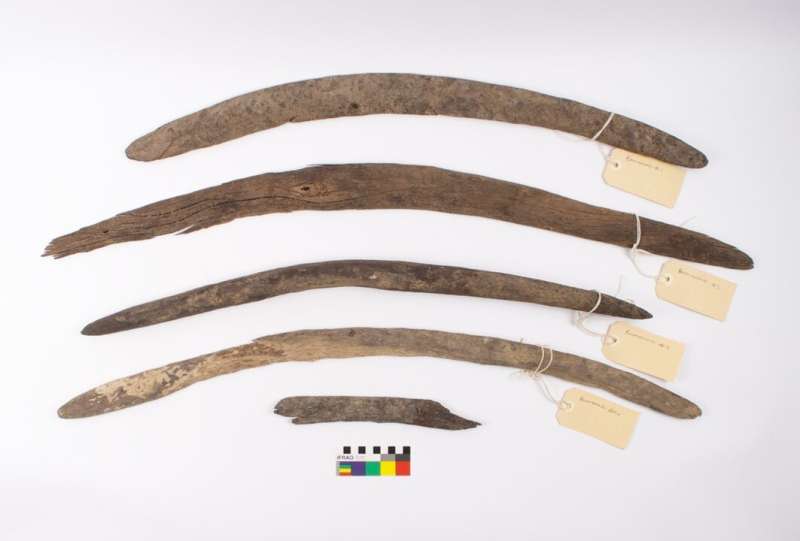
New research has analyzed a rare collection of non-returning boomerangs from Kinipapa (Cooper Creek), near Innamincka in South Australia's far northeast.
The four boomerangs and one wooden fragment were discovered in the creek bed during drought conditions in 2017 and 2018 by Jason Litherland from National Parks and Wildlife South Australia and Katheryn Litherland, a traditional owner.
The project to analyze the artifacts was a collaborative venture initiated by the Yandruwandha Yawarrawarrka Traditional Landowners (Aboriginal Corporation).
They partnered with Australian Heritage Services, Flinders University and the Australian Nuclear Science and Technology Organisation to carefully document the objects and to conduct radiocarbon dating to determine their ages.
The results of radiocarbon dating revealed that the boomerangs range in age from circa 1650–1830 AD, a time that spans the two centuries leading up to European incursions into the region by explorers such as Sturt, Burke, and Wills.
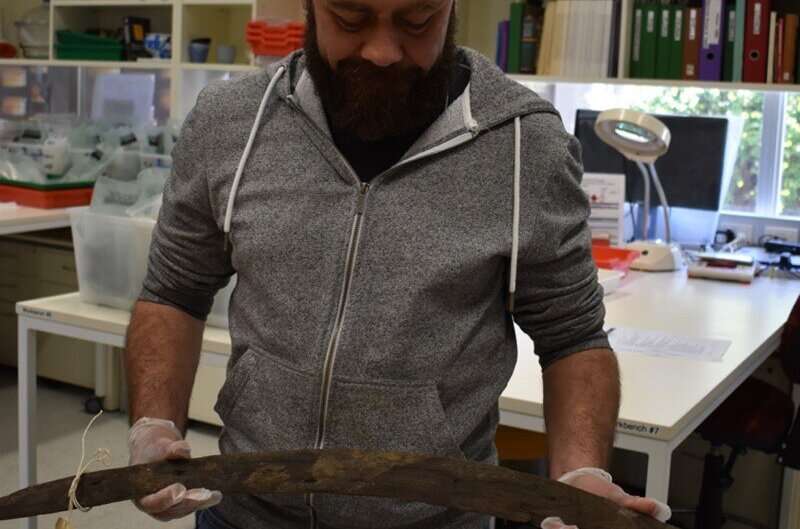
"The assemblage reveals a variety of form and function representative of the diverse cultural activities and daily lives of the Aboriginal people who lived near significant waterholes in the Cooper Creek region during this period," said Professor Amy Roberts of Flinders University.
The authors concluded that in addition to their likely use as projectiles, the boomerangs were probably used for fighting, hunting, digging, fire management and possibly in ceremonies.
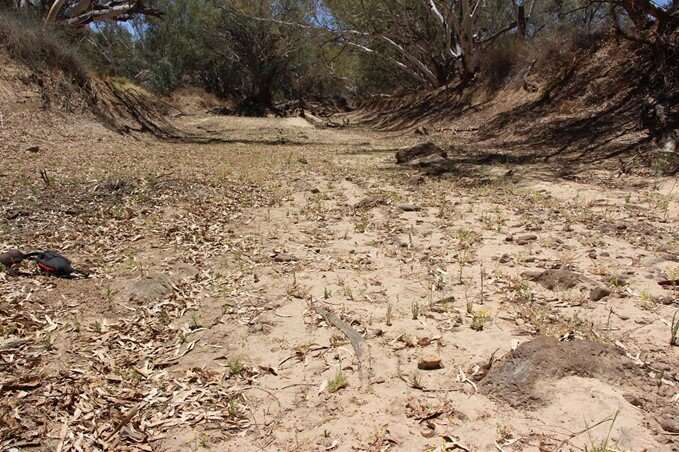
"This range of activities goes well beyond the stereotype of the returning boomerang known to most Australians," said co-author Dr. Daryl Wesley from Flinders University.
"For Yandruwandha and Yawarrawarrka people, the finds provide another example of how their Country continues to tell the stories of their ancestors, as well as affording a tangible connection to the knowledge passed down from their families," said Joshua Haynes, a Yandruwandha Yawarrawarrka traditional owner and co-author.
"We will continue to protect and preserve our artifacts on Country, that's what our ancestors would want us to do. When you see them old people in whirly winds you know they are here watching and protecting our Country," said Katheryn Litherland, a Yandruwandha Yawarrawarrka traditional owner and co-author.
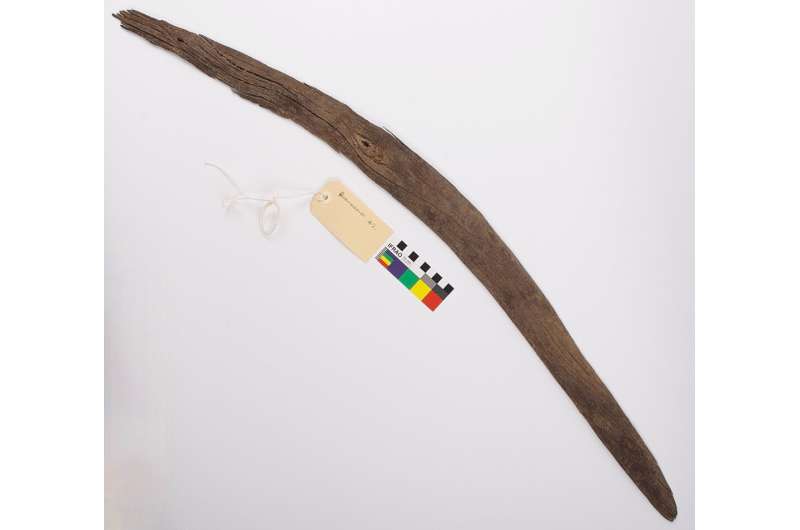
Predictions for climate change in the region threaten to alter the conditions that allowed the preservation of these artifacts, which may affect the potential survival of other wooden objects that remain in the environment.Boomerangs return with greater insights into ample uses
More information: Amy Roberts et al, Morphological Analysis and Radiocarbon Dating of Non-Returning Boomerangs from Cooper Creek/Kinipapa, Australian Archaeology (North-East South Australia) (2021). DOI: 10.1080/03122417.2021.1994685
Provided by Flinders University
World's largest whales eat more than previously thought, amplifying their role as global ecosystem engineers
by Smithsonian
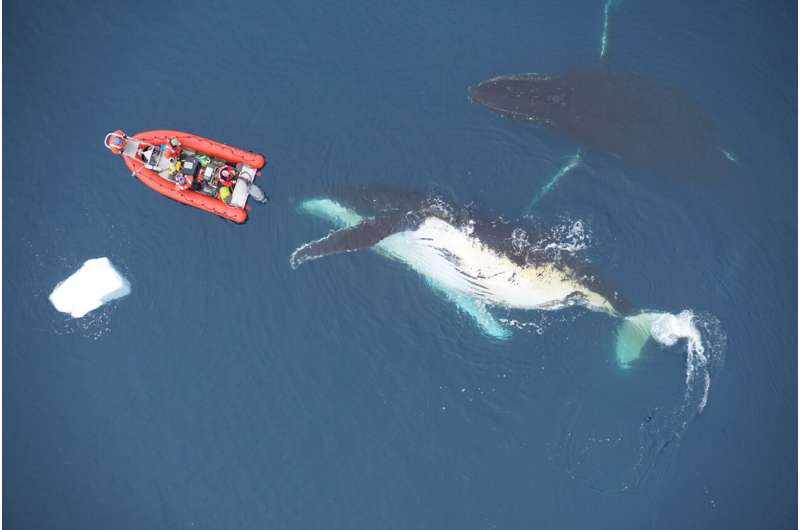
New research co-authored by Nicholas Pyenson, curator of fossil marine mammals at the Smithsonian's National Museum of Natural History, shows evidence that the world's largest whales have been sold short. The study, published today in the journal Nature, finds that gigantic baleen whales—such as blue, fin and humpback whales—eat an average of three times more food each year than scientists have previously estimated. By underestimating how much these whales eat, scientists may also have been previously underestimating the importance of these undersea giants to ocean health and productivity.
Since whales eat more than previously thought, they also poop more, and whale poop is a crucial source of nutrients in the open ocean. By scooping up food and pumping out excrement, whales help keep key nutrients suspended close to the surface where they can power blooms of the carbon-absorbing phytoplankton that form the base of ocean food-webs. Without whales, those nutrients more readily sink to the seafloor, which can limit productivity in certain parts of the ocean and may in turn limit the capacity of ocean ecosystems to absorb planet-warming carbon dioxide.
The findings come at a pivotal moment as the planet faces the interconnected crises of global climate change and biodiversity loss. As the planet warms, the oceans absorb more heat and become more acidic, threatening the survival of food sources that whales need. Many species of baleen whales also have not recovered from industrial whaling during the 20th century, remaining at a small fraction of their pre-whaling population sizes.
"Our results say that if we restore whale populations to pre-whaling levels seen at the beginning of the 20th century, we'll restore a huge amount of lost function to ocean ecosystems," Pyenson said. "It may take a few decades to see the benefit, but it's the clearest read yet about the massive role of large whales on our planet."
Surprisingly, some basic biological questions remain unanswered when it comes to the world's biggest whales. Marine ecologist and Stanford University postdoctoral fellow Matthew Savoca, one of Pyenson's collaborators and lead author of the study, found himself confronted by one of these remaining mysteries: how much the massive filter-feeding baleen whales ate each day.
Savoca said the best estimates he encountered from past research were guesses informed by few actual measurements from the species in question. To crack the conundrum of just how much food 30- to 100-foot whales eat, Savoca, Pyenson and a team of scientists used data from 321 tagged whales spanning seven species living in the Atlantic, Pacific and Southern Oceans collected between 2010 and 2019.

Savoca said each of these tags, suction-cupped to a whale's back, is like a miniature smartphone—complete with a camera, microphone, GPS and an accelerometer that tracks movement. The tags track the whales' movements in three-dimensional space, allowing the team to look for telltale patterns to figure out how often the animals were engaged in feeding behaviors.
The data set also included drone photographs of 105 whales from the seven species that were used to measure their respective lengths. Each animal's length could then be used to create accurate estimates of its body mass and the volume of water it filtered with each mouthful. Finally, members of the team involved in this near-decade-long data collection effort used small boats equipped with echo-sounders to race to sites where whales were feeding. The echo-sounders use sound waves to detect and measure the size and density of swarms of krill and other prey species. This step was crucial empirical grounding for the team's estimates of just how much food the whales might be consuming.
By braiding these three lines of evidence together—how often whales were feeding, how much prey they could potentially consume while feeding and how much prey was available—the researchers could generate the most accurate estimates to date of how much these gargantuan mammals eat each day and, by extension, each year.
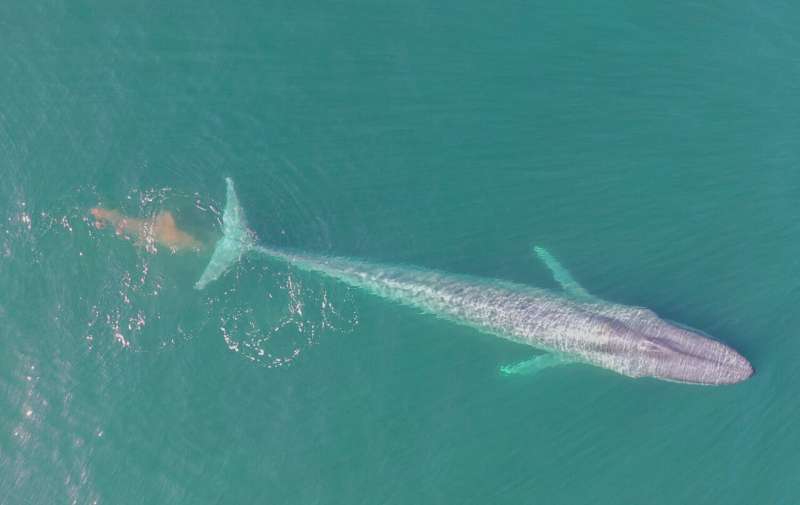
For example, the study found an adult eastern North Pacific blue whale likely consumes 16 metric tons of krill per day during its foraging season, while a North Atlantic right whale eats about 5 metric tons of small zooplankton daily and a bowhead whale puts down roughly 6 metric tons of small zooplankton per day.
To quantify what these new estimates mean in the context of the larger ecosystem, a 2008 study estimated that all of the whales in what is known as the California Current Ecosystem, which stretches from British Columbia to Mexico, required about 2 million metric tons of fish, krill, zooplankton and squid each year. The new results suggest that the blue, fin and humpback whale populations living in the California Current Ecosystem each require more than 2 million tons of food annually.
To demonstrate how more prey consumption by whales increases their capacity to recycle key nutrients that might otherwise sink to the seafloor, the researchers also calculated the amount of iron all this extra whale feeding would recirculate in the form of feces. In many parts of the ocean, dissolved iron is a limiting nutrient, meaning that there might be plenty of other key nutrients such as nitrogen or phosphorus in the water, but a lack of iron prevents potential phytoplankton blooms. Because whales eat so much, they end up ingesting and excreting substantial amounts of iron. Prior research found whale poop has around 10 million times the amount of iron found in Antarctic seawater, and because whales breathe air they tend to defecate near the surface—just where phytoplankton need nutrients to help power photosynthesis. Using past measurements of the average concentrations of iron in whale poop, the researchers calculated that whales in the Southern Ocean recycle roughly 1,200 metric tons of iron every year.
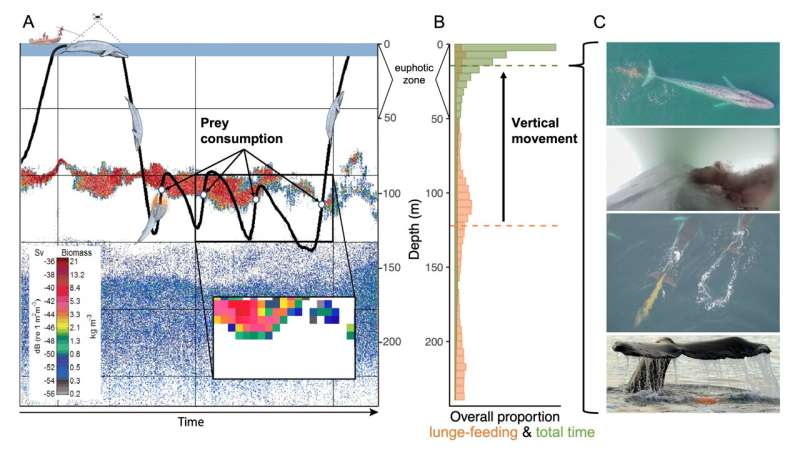
These surprising findings led researchers to investigate what their results might tell them about the marine ecosystem before industrial whaling slaughtered 2 to 3 million whales over the course of the 20th century. Based on whaling industry records of animals killed in the waters surrounding Antarctica in the Southern Ocean, the researchers used existing estimates of how many whales used to live in the region combined with their new results to estimate how much those animals likely ate.
According to the analysis, minke, humpback, fin and blue whales in the Southern Ocean consumed some 430 million metric tons of krill annually at the beginning of the 1900s. That total is double the amount of krill in the entire Southern Ocean today and is more than twice the total global catch from all human wild-capture fisheries combined. In terms of the whales' role as nutrient recyclers, the researchers calculate that whale populations, before losses from 20th-century whaling, produced a prodigious flow of excreta containing 12,000 metric tons of iron, 10 times the amount whales currently recycle in the Southern Ocean.
These calculations suggest that when there were a lot more whales chowing down on krill, there must have been a lot more krill for them to eat. Savoca said that the decline of krill numbers following the loss of so many of their biggest predators is known to researchers as the krill paradox and that the decline in krill populations is most pronounced in areas where whaling was especially intense, such as the Scotia Sea between the Southern Ocean and the Atlantic Ocean southeast of South America.
"This decline makes no sense until you consider that whales are acting as mobile krill processing plants," Savoca said. "These are animals the size of a Boeing 737, eating and pooping far from land in a system that is iron-limited in many places. These whales were seeding productivity out in the open Southern Ocean and there was very little to recycle this fertilizer once whales were gone."
The paper posits that restoring whale populations could also restore lost marine productivity and, as a result, boost the amount of carbon dioxide sucked up by the phytoplankton—which are eaten by krill. The team estimates that the nutrient cycling services provided by pre-whaling populations at the start of the 20th century might fuel a roughly 11% increase in marine productivity in the Southern Ocean and a drawdown of at least 215 million metric tons of carbon, absorbed and stored in ocean ecosystems and organisms in the process of rebuilding. It is also possible these carbon reduction benefits would accrue year over year.
"Our results suggest the contribution of whales to global productivity and carbon removal was probably on par with the forest ecosystems of entire continents, in terms of scale," Pyenson said. "That system is still there, and helping whales recover could restore lost ecosystem functioning and provide a natural climate solution."
Pyenson said he, Savoca and others are pondering what the impact of whales might be if the team had been less conservative with their estimates, as well as a potential line of research comparing the relatively recent losses of large mammals in the sea to those lost on land, such as the American bison. Though based at Stanford, Savoca will continue his work this fall at the Smithsonian collecting samples from its extensive baleen whale collections.Study suggests climate change could prevent recovery of southern right whales
More information: Matthew Savoca, Baleen whale prey consumption based on high-resolution foraging measurements, Nature (2021). DOI: 10.1038/s41586-021-03991-5. www.nature.com/articles/s41586-021-03991-5
Journal information: Nature
Provided by Smithsonian